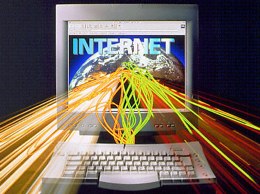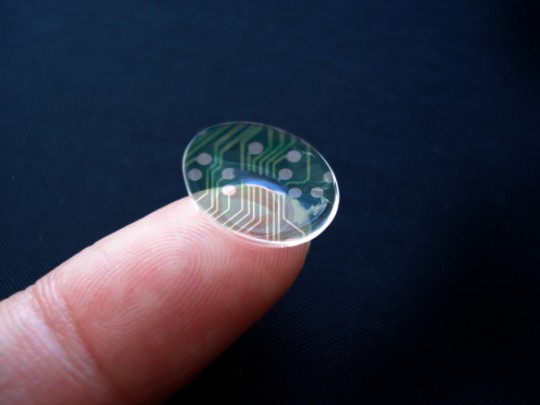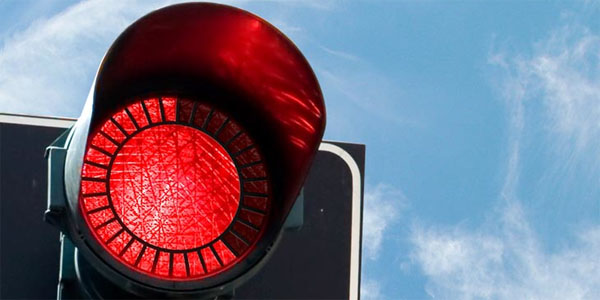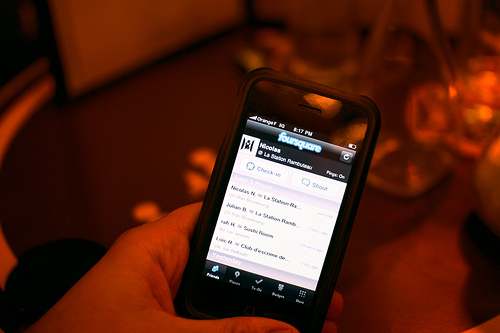Friday, December 04. 2009
Co-presence in the 21st century
Two persons in the same place, as represented on the Foursquare interface. A depiction of co-presence mediated by technology.
Co-presence, as described by Zhao can refer to the sense of being together with other people in a remote or a shared virtual environment. To refer back to Goffman, it’s a form of human co-location in which individuals become “accessible, available, and subject to one another“.
The advent of location-based services lead to a new class of situation where people can b both physically copresent (what Zhao calls “Corporeal Copresence”) and located in electronic proximity (what Zhao calls “Corporeal Telecopresence”). Which is what happens with the Foursquare interface. The categories are then not mutually exclusive.
Why do I blog this? curiosity about what this kind of constraints can lead to, in terms of location-based services in a physically co-present context.
-----
Via Pasta & Vinegar
Personal comment:
Not that it is a new concept, just to underline it one more time!
The Next Phase of Google’s Internet: Google Public DNS
Remember that rumor a while back that Google was going to build its own version of the Internet? It turns out that the idea might not be so far-fetched after all.
 Last month, Google revealed that it was working on its own protocol that could perhaps one day replace HTTP, dubbed SPDY. Today, Google announced that it’s going after another fundamental piece of the Internet: DNS.
Last month, Google revealed that it was working on its own protocol that could perhaps one day replace HTTP, dubbed SPDY. Today, Google announced that it’s going after another fundamental piece of the Internet: DNS.
Google has launched what they’re calling Google Public DNS. Here’s how and why Google says they’re attacking the issue:
“You could think of it as the switchboard of the Internet, converting easy-to-remember domain names — e.g., www.google.com — into the unique Internet Protocol (IP) numbers — e.g., 74.125.45.100 — that computers use to communicate with one another.
Our research has shown that speed matters to Internet users, so over the past several months our engineers have been working to make improvements to our public DNS resolver to make users’ web-surfing experiences faster, safer and more reliable.
As people begin to use Google Public DNS, we plan to share what we learn with the broader web community and other DNS providers, to improve the browsing experience for Internet users globally. The goal of Google Public DNS is to benefit users worldwide while also helping the tens of thousands of DNS resolvers improve their services, ultimately making the web faster for everyone.”
While “speed” might indeed be the end result for users, the data could be immensely valuable to Google as a company that is increasingly all about gathering more and more information from multiple channels in order to serve better advertising. Here’s what Google does have to say about the new DNS service and data collection:
“In the permanent logs, we don’t keep personally identifiable information or IP information. We do keep some location information (at the city/metro level) so that we can conduct debugging, analyze abuse phenomena and improve the Google Public DNS prefetching feature. We don’t correlate or combine your information from these logs with any other log data that Google might have about your use of other services, such as data from Web Search and data from advertising on the Google content network. After keeping this data for two weeks, we randomly sample a small subset for permanent storage.”
If you want to try Google DNS for yourself, there’s already a site that will tell you how to do it, complete with toll-free telephone support.
Like many Google projects, this one will likely take many months if not years to gain traction with users, but nonetheless, it’s going to be yet another interesting piece of the Google puzzle to keep an eye on.
-----
Via Mashable
Personal comment:
Quite worrying I think...
900 Words About Sustainability
The Jargon ETC team is finally publishing our comprehensive post on sustainability. We hold the issue quite dearly here at the blog, but have never gotten to a public definition. Given that sustainability is currently the hottest issue in architectural circles thanks to recent inciting articles by Amanda Baillieu and the upcoming Copenhagen Summit on Climate Change, we feel like now is the opportune time to address the issue.
In the articles below each of our contributors talk about sustainability 300 words. Each author addresses their opinion on its definition and the larger implications of sustainability.
Read it all and give feedback with comments.
----------
Mr. Cuellar
By "sustainable," I understand a productive ecological approach that has no degenerative impact on the earth's natural, chemical life-based cycles and finite resources. The conventional means for achieving sustainable architecture are strictly functional: the building must meet these requirements, expend this little water, contain so much recycled material, etc.
Defining our sustainability strategy as functional would be to ignore the scope and imaginative potential of the issue. Many aspects of building, food production, transportation, and our very societies are unsustainable, and recent waves of eco-paranoia only make this more clear. Sustainability concerns every aspect of our daily lives, therefore the solution to managing resource consumption should, too.
Socially, we are at once bombarded by energy-saving tips and accustomed to long, hot showers.
Psychologically, we face "eco-angst."
Morally, it's difficult to decide whether the perversion of nature is "wrong" or irrelevant, interesting and subject to further perversion.
Politically, we are encouraged to trade in our clunkers, but suburban homeowners' associations forbid street-facing PV panels.
Practically, how could we possibly know for sure whether organic produce from overseas is more sustainable than pesticide-coated local fruit?
The misstep of architects would be to assume that meeting energy and spatial standards alone can cure the germ of today's ecological problems, let alone address our complex habits of consumption.
I propose a temporal and geographical solution, a nomadism, part Johnny Appleseed, part wi-fi addict. Debord's notion that nomads endure a "content less freedom" is helpful to understand the proposal (The Society of the Spectacle, New York, Zone Books, 2006 edition). We can suppose sedentariness produces content (a content-full captivity), but this is obviously unsustainable today. We mustn't adopt new typologies, but radicalize our existing ones. There must be living rhythms and situations, beyond and behind our artificial gardens of Eden, that agitate normalization and make the earth's outside environment fertile and flexible again.
----------
Mr. Grey
There are two leading approaches to architectural sustainability. The first view of sustainability is as an architectural a priori, no different from structure, materials or occupancy. This is the approach which leads to critical solutions and an understanding of entropy. The other approach is that of continual accretion. This second option, used by an army of LEED certified practitioners and advocated by figures as prominent as President Obama, believes that the application of more solar, wind, insulation, and geothermal is the solution to make something sustainable. These answers are built on the myth of capital production as the solution to any obstacle. Despite its wide acceptance, sustainable people should be skeptical of the ‘more’ solution.
The ‘more’ argument has a long history in the West. Children are taught that the Soviet Union collapsed because of the weight of overwhelming amounts of capital production in the West. Likewise, mass production is credited with overcoming the ‘Wild West,’ defeating fascism in Europe, and birthing a semi-autonomous middle class.
Now, facing a climate crisis, the ‘more’ solution resumes its typecasting. Architects embrace the more ideology for its marketability. Large allocations for solar and plant covered buildings dominate current built form and school pedagogies. These can be sold to clients in Dubai or New York without ever thinking about the real differences between these places.
More solutions always parallel the exponential growth patterns of capitalism. There is nothing sustainable about exponential models. Natural entropy is part of any critical sustainable solution; this directly involves architecture, and harks to old precedents.
This architecture, considering the climate a priori, was noted by Vitruvius, shown in the primitive hut by Laugier in 1804 and again by Frank Lloyd Wright. This architecture stops building 'more' for the sake of reparation. It creates critical architecture that requires pursuit of material, form, psychology, and ideology to offer a critical approach to sustainability.
examples : + and -
(+) Laugier: Primitave Hut Wright: Taliesen West Zumthor: Thermal Baths Roche: Hybrid Muscle
(-) Piano: Vulcano Buono SOM: Pearl River Tower DWELL magazine: Normandy Chapel
----------
Mr. Langevin
Environment as Sustainability
The question of sustainability is a question of environment. “Environment” (or some form of the term) has long been part of the public consciousness, beginning in the 1960’s with Rachel Carson’s Silent Spring, continuing into the 1970’s with the conservation movement, and remaining relevant to current discussions about climate change and global warming. While the general understanding of “environment” has evolved during these decades, the exploration of the distinctly human type of environment has lagged behind, stymied by the practice of standardizing the atmospheres that our buildings provide. Going forward, attempts to redefine these unsustainable built environments will provide the basis for a real sustainable revolution.
The word “environment” describes a complex network of interdependent variables that change across time and space. Variability is crucial in establishing an environment’s capacity for diversity, flexibility, and adaptability, all of which are tenets of fundamentally sustainable systems. Earth’s natural environment acts as one such variant ecosystem on a large scale, transforming by day and season in a cyclical process that continues on indefinitely into the future.
Since the advent of air-conditioning, the human environment has been uniquely divorced from the notion of variability, striving instead for predictability through strict mechanisms of control. Standardization has neutralized the climatic context of buildings by defining an artificially tempered interior that can be implemented in any corner of the world, provided a big enough HVAC system and tight enough exterior envelope. In these spaces, the occupant is deterministically reduced to the passive recipient of prescribed target conditions.
A sustainable human environment cultivates lower human energy use, higher sensory engagement, and increased productivity by integrating with surrounding ecosystems and embracing internal variability. Drawing from the diurnal and seasonal transformations of the natural climate, the environment acts as its own smaller ecosystem that evolves over time in a similarly cyclical manner. Efforts to achieve this atmospheric dynamic within a building are rare and difficult to pursue, as the addiction to climate control runs deep and is firmly entrenched in prevailing codes and guidelines. Nevertheless, they provide an essential challenge to the human environments most responsible for mankind’s dissonance with the Earth, and in doing so access the heart of the answers to the sustainability question.
-----
Via Jargon, etc.
Related Links:
Personal comment:
"The word “environment” describes a complex network of interdependent variables that change across time and space. Variability is crucial in establishing an environment’s capacity for diversity, flexibility, and adaptability, all of which are tenets of fundamentally sustainable systems. Earth’s natural environment acts as one such variant ecosystem on a large scale, transforming by day and season in a cyclical process that continues on indefinitely into the future."
and further away:
"The word “environment” describes a complex network of interdependent variables that change across time and space. Variability is crucial in establishing an environment’s capacity for diversity, flexibility, and adaptability, all of which are tenets of fundamentally sustainable systems. Earth’s natural environment acts as one such variant ecosystem on a large scale, transforming by day and season in a cyclical process that continues on indefinitely into the future."
These are quotation from "Mr. Langevin" to which I quite agree and that make me think to what we tried to "pinpoint" (the airconditioning as a non variable functional and comfortable environment) in the project RealRoom(s). It also make me think of another research project about space variability we worked on: Variable environment, even if this one is not really focused on sustainability. It could be a side aspect of it, I think in particular of Rolling Microfunctions"
Opto-electronic contact lenses promise wireless displays
The opportunity to jab yourself in the eye with a tiny computer display is one step closer, thanks to the ongoing work with opto-electronic contact lenses taking place at the University of Washington in Seattle. The lab there has been showing off the latest prototype, the handiwork of Dr. Babak Parviz: a semi-transparent array – including an LED – embedded into a lens that receives 330 microwatts of power wirelessly from a nearby RF transmitter. Parviz has been using the prototypes to display biosensor feedback about the wearer’s vital signs, but they’ll eventually serve as a heads-up display for displaying other data. The wireless power is picked up by a loop antenna built into the lens, and future iterations of the hardware are expected to integrate the transmitter into a cellphone. There’ll also be far many more LEDs involved, so that the resolution is high enough to be useful. “Conventional contact lenses are polymers formed in specific shapes to correct faulty vision. To turn such a lens into a functional system, we integrate control circuits, communication circuits, and miniature antennas into the lens using custom-built optoelectronic components. Those components will eventually include hundreds of LEDs, which will form images in front of the eye, such as words, charts, and photographs. Much of the hardware is semitransparent so that wearers can navigate their surroundings without crashing into them or becoming disoriented” Dr Parviz, University of Washington in Seattle Future plans see the opto-electronic lenses being used for more than just displaying data; they’ll also be able to monitor the eye’s surface chemistry, which would allow wearable computers to keep track on blood sugar levels in diabetics and other information. Parviz’s eventual goal is the contact lens becoming a platform “like the iPhone is today”, with developers creating custom apps. However it seems that’s a reasonably long way off into the distance.
Via Slashdot
Eko: A Traffic Light Augmented by Progress Bars

The Ecological and Economical Traffic Light Concept [relogik.com] by Damjan Stankovic is a Red Dot Design 2009 Award winner and consists of a simple yet, potentially highly practical visualization concept for everyday traffic lights that could reduce pollution and promote safer driving. There might already be quite some traffic light time counters around today, but few focus on informing the car drivers in a physically integrative and visually glanceable way like this proposed design concept.
Eko Light is specifically designed so it can be easily installed onto existing traffic light systems without much effort. It claims to bring forward following benefits:
- Less pollution, as drivers can turn their engines off and cut carbon emissions while waiting for the green light,
- Less fuel consumption, as turning off vehicle engines lowers fuel consumption in the long run,
- Less stress, since drivers know exactly how long to wait, and
- Safer driving, as all traffic participants are fully aware of how much time they have left before the light changes, reducing the chance for potential traffic accidents.
fabric | rblg
This blog is the survey website of fabric | ch - studio for architecture, interaction and research.
We curate and reblog articles, researches, writings, exhibitions and projects that we notice and find interesting during our everyday practice and readings.
Most articles concern the intertwined fields of architecture, territory, art, interaction design, thinking and science. From time to time, we also publish documentation about our own work and research, immersed among these related resources and inspirations.
This website is used by fabric | ch as archive, references and resources. It is shared with all those interested in the same topics as we are, in the hope that they will also find valuable references and content in it.

